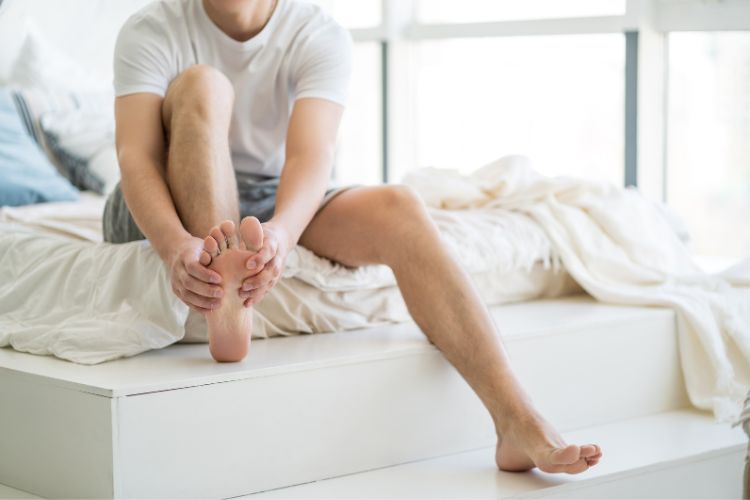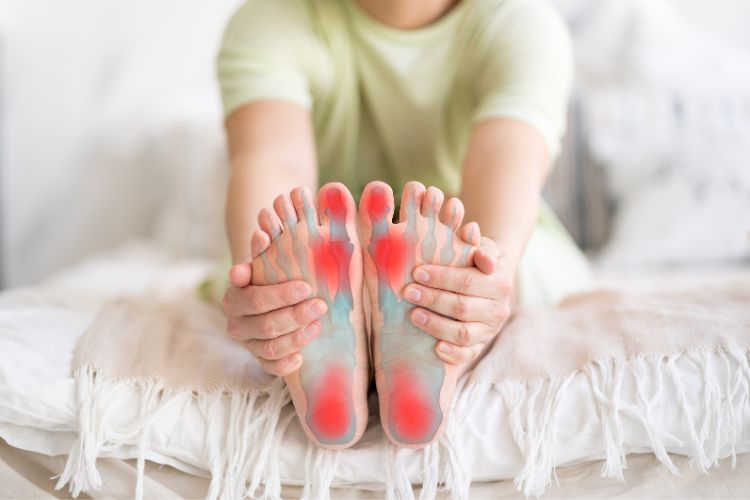It is estimated that rheumatoid arthritis (RA) impacts approximately 18 million people all over the world. Of those, 90 percent will experience rheumatoid arthritis foot pain. That is because, in many people with RA, the foot will be the first place of the body where RA will begin to show. Symptoms of rheumatoid arthritis in the foot include inflammation and swelling, corns and painful bunions, and burning pain that is difficult to relieve. For patients suffering from rheumatoid arthritis foot pain, soreness, and swelling are daily things they have to live with.
In addition to dealing with the pain, you’ll have to live with the impact that this disease has on your overall life and health. Taking care of your feet is an essential component of RA, as disease or infection that begins in the foot can take hold of your whole life.
When you are living with rheumatoid arthritis, there are many ways to find arthritis foot pain relief. Use this guide for managing foot pain in rheumatoid arthritis and developing foot care strategies for rheumatoid arthritis today.
Understanding the Causes of Foot Pain in Rheumatoid Arthritis
The causes of rheumatoid arthritis foot pain are many. The symptoms of this condition include inflammation, swelling, and a burning pain that feels like it will never go away. Every area of the foot may be impacted by RA pain, and you’ll need to take care of every symptom. The joints between the bones are called interphalangeal joints and they will need to be soothed and comforted regularly to ensure that your foot pain does not go beyond your control.
You also have metatarsophalangeal joints that connect the smaller bones in your feet to the longer bones of your feet and legs. In rheumatoid arthritis, these joints will become inflamed to a point where it could feel unbearable. This pain will also cause you to walk differently, which will result in corns and bunions to your feet. The subtalar joints of the heel and the leg bones will also be impacted by this condition.
All of these causes will result in rheumatoid arthritis foot pain that will feel difficult to treat. You may also see thick nodules or bumps on the foot, or hardened patches of skin. This could be part of the condition or a result of your changing gait as you deal with foot pain. When you do not treat these symptoms with foot care strategies for rheumatoid arthritis, your pain will worsen and your quality of life will decrease.

Symptoms and Diagnosis
Symptoms of rheumatoid arthritis will vary by the individual, but burning pain and stiffness are the first symptoms of this disease. You will also experience these symptoms in your feet. In your foot, it may feel like it is difficult to move your toes or even wiggle your ankle around when you are having a flare up. It will also feel like your foot is chronically achy or sore, and you will find these symptoms worse after standing or walking for extended periods.
Warmth and burning are common markers of rheumatoid arthritis. You may feel it in specific areas of your foot and toes. Or you may feel it throughout your entire foot, depending on how serious your arthritis condition is. Swelling is another common symptom of RA, and you will see that your feet feel and look bigger than they normally should.
Many or all of these symptoms should be present for a rheumatoid arthritis diagnosis, but your doctor will perform blood tests as well. When you see a doctor for this condition, your doctor will want a thorough medical history and family history to see if anyone else has had this condition. Your doctor may already notice the symptoms of rheumatoid arthritis from your first few appointments. You will also get X-rays and blood tests to determine if the rheumatoid antibody is present, which will help your doctor come to this important diagnosis.
The Secret Weapon: Effective Foot Pain Relief Strategies
There are many foot care strategies for rheumatoid arthritis that you can start today, before or even in between your doctor’s appointments. The RICE method of rest, ice, compression, and elevation is a well-known secret weapon for combating rheumatoid arthritis. Use these steps as often as you can during your day during a flare-up. You will find comfort in the ease and elevation, and with the healing that can come with rest.
Soaking your feet in warm water has both a psychological impact and a physiological impact. It is the physiological impact on your feet that creates the overall feeling of comfort and relaxation. Simply unwinding during a flare-up can bring your flare-ups down considerably. You will experience wonderful relief from RA foot pain by investing in a foot spa that you can soak your poor feet in whenever you are dealing with this burning pain.
Your doctor will also talk to you about pain management strategies and strategies like orthopedic foot care. You may want to get inserts for your shoes and may learn to wear shoes differently. Medications such as non-steroidal anti-inflammatory medication will help reduce the inflammation that comes with RA, and most of this you can get over the counter. You may want to try topical solutions as well that can reduce the burning.
At the same time, your doctor may need to prescribe stronger medication that will reduce inflammation and help with pain relief as well. Steroid injections are common for people with RA, and can greatly help to bring relief and reduced swelling to affected areas. There are also medications specifically for RA known as disease-modifying antirheumatic drugs that can help to relieve pain and reduce some of the more serious symptoms. Additionally, physical therapy or special boots or braces can help to improve your gait and your quality of life considerably.

Lifestyle Adjustments for Foot Pain Management
When you are looking for arthritis foot pain relief, you may find that you have to change your entire lifestyle, whether you want to or not. Some of those changes will come organically and naturally as you begin to cope with this life-changing pain. Rheumatoid arthritis is not curable, but it can be treated very effectively. You will want to integrate many different lifestyle adjustments to help you live a more positive and healthy life.
Most importantly, the life you want to live will need to be about improving your pain levels and improving your daily life. Regular exercise is an important component of this. Although it may feel like you are in too much pain to exercise, you may find that incorporating regular exercise into your everyday life will help with your rheumatoid arthritis foot pain. Exercise has a natural way of releasing endorphins that block the nerve signals in your brain that tell you that you are in pain.
Endorphins are always working when we are stressed or in pain, and in some cases, they prevent us from feeling pain. You can increase the level of your “endorphin rush” through exercise and activities that will help you to feel less stress and anxiety. Spending time with people who love you has a funny way of doing that too. When you are loved, those endorphins are blocking both stress and pain signals, and you are going to experience more relief from rheumatoid arthritis foot pain.
More endorphins in your life will also reduce the emotional toll that this disease will take on you. You will also benefit from a healthier diet that is rich in fruits and vegetables. There are many fruits and vegetables that are known to have anti-inflammatory properties, like tomatoes, olive oil, and leafy veggies. You want to avoid foods that cause inflammation, like fried foods, soda, and processed carbohydrates.
Overall, you want to manage your weight in a healthy way that doesn’t interfere with your desire to enjoy life. With a healthy weight, your gait will improve, and you will feel better overall and will experience less pain in your joints. You also want to minimize some things in your life, like alcohol, and quit smoking completely if you are a smoker. As you cope with rheumatoid arthritis foot pain, you may also want to look for community resources like support groups or low-impact exercise classes that can help you to succeed in managing foot pain in rheumatoid arthritis.
Best Practices for Preventing Rheumatoid Arthritis Foot Pain
In addition to developing foot care strategies for rheumatoid arthritis and finding ways to cope with and relieve pain, you will want to develop strategies that help you to prevent foot pain completely. Again, some of these things will come naturally while others will be learned as you deal with this new way of life. Your footwear will become something in your life that you think about a lot. You will want to begin to wear open-toed shoes more, and buy shoes that are larger by approximately one-half to one full shoe size.
This will help you to walk as you want to and avoid some of the flare-ups that come with RA. Staying warm will become something you have to live with and deal with regularly. Invest in cozy blankets, robes, and sweaters that will make you feel happy and comfortable. You may also want to develop a new routine where you take longer baths instead of showers.
If you can, get into a jacuzzi habit when you know you might experience a flare up but aren’t there already. Join a local gym or spa that has one if you can not put one in your own home. These are miracle baths that will help to reduce the stiffness in your joints and your body and prevent your feet from swelling or flaring up. If you are worried about flare-ups, you want to avoid exercise and stay away from strenuous activity or extended standing or walking periods as well.
This may mean that you will need to change jobs or even stop working completely. Sadly, for some people, this often ends up being the case when the disease progresses, but you can find preventive methods in your current workplace if you have one to find relief from rheumatoid arthritis foot pain. Getting more sleep will always be a useful tool when preventing RA as well. A well-rested body can handle flare ups much easier and will be less prone to them as well.
Find Arthritis Foot Pain Relief Today
When you are dealing with rheumatoid arthritis, the burning and swelling pain is everywhere. Use this guide as your secret weapon. With this, you will know what to expect when it comes to this pain, and how to both prevent it and relieve it. Before you try anything new, talk to your doctor, and then begin your new quality of life with relief and comfort using these strategies.
